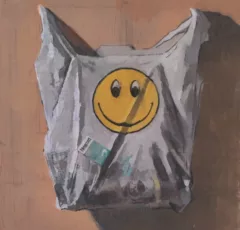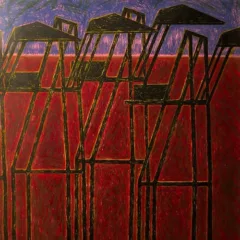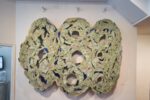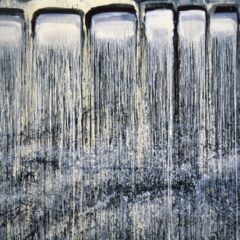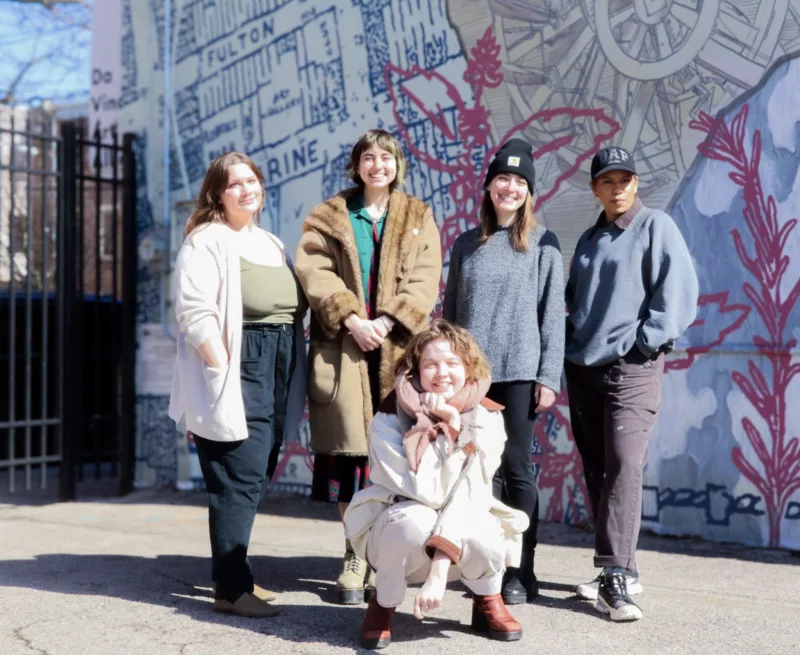
Introduction
We can only hope if we get to 93 that we’re still vital, functioning and able to contribute. Da Vinci Art Alliance (DVAA) has reached that fulsome age, but as its centennial nears, rather than close the curtains, they’ve set the stage to become an organization its founders never envisioned, but that continues the fundamental mission of building community through art.
I first toured Da Vinci’s Catharine Street building with Samantha (Sam) Connors, the Executive Director. After the tour we walked over to Three Graces Coffee and continued our conversation about the history and evolution of the Alliance. Sam discussed how the organization has shifted and adapted over the decades, and where it stands now; its vision and mission in the broader community of Philadelphia. That conversation has been distilled and edited for continuity and readability.
A History Rooted in Community
In 1931, at a time of anti-immigration sentiment when immigrants were barred from participating in the city’s major art institutions, a group of 16 Italian immigrants formed a club of artists and artisans. Painters, bricklayers, woodworkers, violin makers, cabinet makers and others who had brought their skills from Europe, these immigrants helped build the city.
“Our founders were craftspeople. They were barred from the institutional spaces and so they started their own club very much in the tradition of South Philadelphia, a lot of people meeting in homes and studios, all the men and their families. Then in the fifties they opened it up to women.” Sam Connors recounted.
The building on Catharine St.
In 1966, the Alliance purchased a three story building on Catharine Street. They bought a building “intentionally across the street from Fleisher (Art Memorial) where most of our founding members were taking classes or teaching. They always wanted to have that relationship; sharing exhibition space and community. There’s a lot of what we do today that’s inspired by that idea,” Sam said.
The Alliance persisted for the rest of the 20th Century and the beginning of the 21st as a community-based volunteer arts cooperative, operating without a staff, offering shows to members and generating cash through dues and renting out space. Fast forward to 2017. The Alliance had around 35 members. That’s the year Sam joined the organization.
Sam Connors’s background
Sam had moved to Philadelphia when they were 17, attending Moore College of Art and Design for fashion design. Sam explains:
“By the time I made it to my junior year, I was triple majoring…and the thing I liked least was fashion design! I left school and ended up at Tyler School of Art and Architecture and finished with my degree in Fiber and Material Studies and Art History. In 2015, I began as an apprentice for Dianne Koppisch Hricko, a dye artisan printmaker. I also worked for her husband Richard Hricko and helped him with his printmaking process as well as applying to shows, researching opportunities and grant writing. I slowly started picking up more and more clients until I was full-time as a kind of artists’ business manager. I always say that when I took on the role at DaVinci I went from having five bosses as a freelancer to having more than 225 (DaVinci’s current membership).“
Over the course of their college years and as a young professional there were other passions that drove Sam. They were a committed volunteer community organizer, helping to support work done by CADBI (Coalition Against Death by Incarceration), OccupyICE, and the Harm Reduction Coalition.
“I spent the last 10 years working with mutual aid and direct action spaces. I had a lot of organizing experience when I came into this job”. “In 2017 a friend, Nile Overton, a hip hop artist and curator, had a pop-up at DaVinci that I attended, and that’s really the first time I became aware of the Alliance.”
One month after signing up, Sam was asked to participate in the exhibitions committee, and then to serve as its co-chair. In 2021 when Jarrod Markman left as Executive Director, Bryant Girsch and Samantha applied for the role and were appointed as Co-Executive Directors. Bryant had started working at Da Vinci at about the same time as Sam joined as a member, and they had worked together on committees. “It felt like a very organic fit for both of us to be co-directors,” they said. Then Bryant’s career as a painter started to take off, with growing attention in Milan, London and Asia, and a new role with MuralArts. When Bryant made the decision to leave Da Vinci, Sam took on the role as sole Executive Director.
Reassessing the Status and Setting New Priorities
Sam is a hands-on, practical leader. In our conversation you could tell they have a natural feel for getting at the heart of a matter and getting priorities straight. For Da Vinci those priorities were physical and financial.
“When Bryant and I started I was able to really look at our books and figure out the stuff we needed to re-strategize. We had a conversation the first week. What are the goals? What do we want to accomplish in the next three years? The first one was making the building ADA (Americans with Disabilities Act) accessible. The second was moving away from a ‘pay to play space’ (i.e. renting out the gallery).”
The organization hadn’t grown up with a full time staff, a financial structure or a formal business plan. Sam and Bryant got down to the hard work of creating that right foundation. Sam spoke quite a bit about the state of the building and what needed to be done in the coming years.
“We’re preparing a grant for the construction plans. If everything works out, the way it’s working out in my brain right now, we’ll have an entryway that’s ground level and we’ll expand and upgrade the facilities like HVAC, putting in an elevator to serve all four floors, expanding the third floor, etc. The plan is to move into a (nearby) rental space (during construction) so we can stay in our neighborhood. We love our neighbors and love being near Fleisher. We want everything completely renovated by our 100th anniversary in 2030/31.”
As co-directors, Sam and Bryant also decided to streamline what had become Da Vinci’s complex member dues structure.
“Bryant and I decided to change to a sliding scale membership based on declared need, from zero to $300. That made it a lot more accessible and equitable for people. That’s very important to us. At the root of everything is equitability and accessibility.”
What you also realize, in conversation, is that they have other bedrock expectations rooted in how they believe we should treat one another, like how visitors feel when they come into the gallery. And, as a society, how we connect with and support marginalized communities.
“Having a welcoming staff is important. My view is the executive director and staff are here to serve. A couple months into my job I walked into a gallery (I’m not going to name names). I wanted to see this show and as I walked in, two guys with black turtlenecks looked me up and down, and didn’t say a word and looked back down. I was so offended. It’s customer service. We want to hire people who genuinely care.”
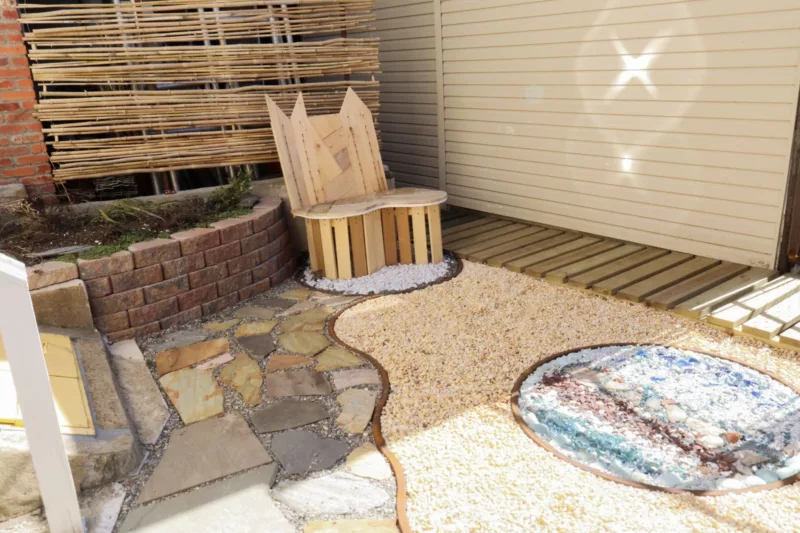
A caring community
Caring sends its branches outward and becomes caring about and engaging the community. “A lot of our artists are doing politically motivated work. They’re talking about the infrastructure of the city and (aspects of) the world that are unjust. So we’re hiring people like that…that are rooted in justice principles. We’ve always tried to represent marginalized communities. It’s just inherent in the type of work (that we show), but we’re pushing it a little further.”
Sam and Bryant made it a requirement that fellowship and project shows include a community engagement element.
“We thought we would get more push back about it, but to be honest, our membership is really embracing it. They really like having a conversation…I’m used to working in my studio…how do I do something to engage people publicly?
Listening to Sam you hear there are other priorities, but they are waiting in line. Sam knows they need to execute what’s on the table and then build on those successes…building momentum by skillfully putting one foot in front of the other.
An Explosion of Programming and Outreach
We can’t capture all the programming underway or under development. But to give you a taste let’s hear Sam, in their own words, describe some of the big pieces.
“We have three galleries. Two of them change monthly. The third floor space is a flex space. Sometimes we have pop-ups. We have four quarterly member exhibitions. Three are curated and one is an all member show. Even though we’re moving to curated shows, everyone is guaranteed to be in at least one member show every year. That’s opened us up to have a lot more experimental work, and really have a connecting thread in the exhibition. There’s a committee of about 30 people that work together to create the theme and then select the work.
“That same committee reviews our fellowship and residency applications. In 2018, we founded our fellowship program, which offers four separate tracks. In 2021, we worked with our building committee to renovate the third floor into three separate spaces instead of one single studio apartment. This allowed us to expand the Fellowship to include a Residency program. The program supports 10 artists each year where they each get a month of studio space with 24 hour access and support from the entire team. Our programming coordinator meets with them weekly and figures out what resources they need, helping them navigate…whether it’s galleries, materials, how to build a website, social media presence, all those things that are so integral to our practices now. It’s a yearlong cohort where they come to professional development workshops and build a community with one another.”
Partnerships all over the city
“We have programming and partnerships all over the city. We have a K-12 program called “STEAM explorers” where the kids come to the gallery and learn directly from the artists and staff. The plan is to expand that program into more under-resourced schools…At the school we work with now, students often don’t have recess because there are needles in the recess area, so part of it is getting them bused down here so they can play in Palumbo Park.”
“We also work with the Boys and Girls Club and starting next month we’re going to have a monthly, family day drop-in workshop. People can come with their kids and their whole family. We’re talking about intergenerational learning. It’s not just dropping off your kids so you can get a cup of coffee around the corner. It’s working with your kid and creating something together.”
Sam went on to talk about panel discussions with Heather Marie Scholl, a former fellow, on queer partner violence and last month’s Creative Conversations panel discussion about Art and Censorship. That event featured: Leila Delicious, a Palestinian burlesque dancer; Romana Lee-Akiyama, their 2024 Michelle Angela Ortiz fellow, and Kara Mshinda, their Fellowship director. Clearly, outreach to marginalized communities forms the thread running through so much of what the new Da Vinci has become.
What does Philly need to nurture the arts?
I posed one of Roberta Fallon’s (The Artblog Executive Director and Editor) favorite questions ‘What would you do if you had $5 million?’ Sam said they’d been thinking about it all week. Their response…
”There are all these historic houses like the Dox Thrash House, the Paul Robeson’s house, Da Vinci (selfishly) that really uplift history, and also create space for community care. I would give each of those organizations an endowment so they have a nest egg and can better support artists. I think putting the tools back into community spaces that already have the proven ability to do that with (virtually) nothing, to better support artists for years to come. Beyond that, let’s create a grant system to support individual artists. It would be great if we were in New York or LA that has the living artists grants. Especially right now with gentrification.” (writer’s note…please see my Artblog interview with Megan Galardi, founder of Blah Blah, for a more in depth discussion of individual artist’s grants).
Writer’s Conclusion
I’ve visited Da Vinci over the past year and it seems that every time I walk in the energy in the space and the quality of the work on display has taken a step forward. The most recent curated member show looked terrific. You can feel there’s something afoot…something growing and healthy about how the space is put together and how it and the staff engage when you step in the door. It’s a small team, but the momentum is there for Da Vinci to continue to expand its programming and outreach. That in turn will provide the increased visibility and credibility that will set the stage for Da Vinci to begin its second century on the right foundation, growing far beyond its original charter, to become one of Philadelphia’s key, city-wide community-building organizations.
p.s. don’t forget the festival!
As we put down our coffees Sam reminded me that we needed to remind you that during the whole month of April Da Vinci will be partnering with over 50 other organizations across the city for Everyday Futures Fest, to present free sustainability centered art workshops and events. On April 21st, from 12-5pm there’ll be a block party for the whole city arts family all the way down Catharine Street and across Palumbo Park. The team is setting up an event that will make you want to hang out for the entire day!
Da Vinci Art Alliance Staff:
Samantha M Connors (They/Them) – Executive Director
Danielle Degon Rhodes (She/Her) – Outgoing Gallery Director
Kara Mshinda (She/Her) – Fellowship Director
Sara Mae Henke (They/Them) – Programming Coordinator
Jillian M Rock (She/Her) – STEAM Coordinator
L. Elwood (Any Pronouns) – Marketing Coordinator
Visit the Da Vinci Art Alliance website to learn more.


